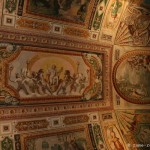Located less than 30 km from Rome, Tivoli is an interesting city easily reachable by train. This is a good idea for a getaway for a day out of the eternal city. From antiquity, the Roman aristocracy built villas following the emperor Hadrian.
The city itself, with its monuments, restaurants and local entertainment, is worth a visit. Moreover, the Romans sometimes come to spend the weekend. But it is especially for its «villas» classified by Unesco that it is prized by tourists. There remain significant remains of the extraordinary Hadrian’s Villa, the immense estate and imperial palace. Of another style and time, Villa d’Este has splendid 16th century gardens embellished with majestic fountains. Villa Gregoriana is a large wooded park with a large waterfall, caves and remains.
Tivoli center
In the historic centre of Tivoli you will find beautiful monuments such as the pretty church of Santa Maria Maggiore, the Cathedral of San Lorenzo. There are also scattered ancient remains such as the Temples of Vesta and Sibyl, the Mausoleum of the Plauti, the Sanctuary of Hercules Victor, or the ancient Mensa Ponderaria on the Roman forum. You can also relax in the modern thermal baths.
Hadrian’s Villa
For its size and good conservation, the Hadrian’s Villa is one of the most important Roman villas in Italy. It is a remarkable example of Roman architecture, which included several innovations. Built from the year 126 AD, it was designed by the emperor Hadrian who was inspired by his recent travels to the eastern provinces, Athens and Alexandria in particular.
Successive emperors embellished it, until Constantine who transferred his works of art to Constantinople at the beginning of the 4th century AD. Destroyed during the barbarian invasions, it later served as a stone quarry for the construction of the buildings of Tivoli.
Among the many places to discover in the villa are the Pecile with its central garden and a basin; the Philosophers’ Hall with its niches; the maritime theatre, with the island in the center of a circular basin surrounded by a colonnade; the two thermal ensembles; the artificial valley of the Canopus inspired by that of Alexandria with its elongated basin, its columns, statues, and the temple-fountain; the complex of the imperial palace with Piazza d’Oro, etc.
Villa d’Este
The Villa d’Este was built in the sixteenth century at the initiative of Cardinal Hippolyte d’Este, using partly marbles from the nearby Hadrian’s Villa.
It is a masterpiece of Italian architecture and mannerist style, with magnificent terraced gardens with many monumental fountains. The latter are fed with the techniques employed by the ancient Romans.
Villa Gregoriana
Villa Gregoriana is a park that extends at the foot of the ancient acropolis of Tivoli, dominated by the remains of two temples, including the Temple of Vesta (or Sibyl).
It is occupied by a wood that is traversed by paths that lead to the caves of Neptune and the Sirens, small gorges and views of the waterfalls, including the Great Cascade of the Aniene River.
Gallery
- Hadrian’s Villa – Canapo
- Hadrian’s Villa: city wall
- Hadrian’s Villa
- Hadrian’s Villa : quadriportico con pescheria
- Fountain in Villa d’Este
- Gardens of Villa d’Este
- Gardens of Villa d’Este
- Villa d’Este
- Temple of Vesta
- Villa Gregoriana
Information and visits
- Tivoli : Wikipedia, official website of villas and monuments
- Hadrian’s Villa : official website, Wikipedia
- Villa d’Este : official website, Wikipedia
- Villa Gregoriana : official website, Wikipedia
Map of Tivoli
If you see this after your page is loaded completely, leafletJS files are missing.


















